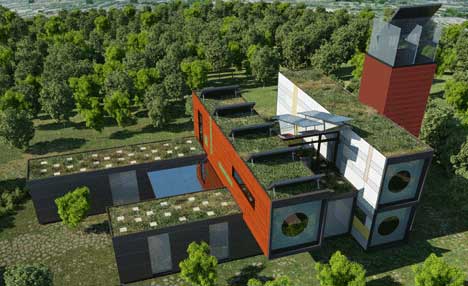12 Jun Sustainable Construction at Construmat: the R4House

Construmat, the biggest International Building Show, opened its doors in Barcelona to welcome thousands of architects, designers, engineers, builders and developers for a week of exchanging ideas, conferences and the latest in the world of construction. We are not surprised (see more ?R projects?) that this year a whole pavilion has been dedicated to Sustainable Construction where you can visit the R4House, designed by the Valencian architect Luis de Garrido.
The R4House prototype consists of two bioclimatic homes (one of 150 m2 and a mini-flat of 30m2) made from materials that close the loop. The energy consumption of both is zero due to its bioclimatic design, the solar panels and the geothermal energy source. The waste production during construction is also zero. Both homes are modular and built from six recycled shipping containers; low-cost and allowing flexibility. The 4 Rs stand for Reuse, Recover, Recycle and Reasoning with the latter being the most important says Garrido. ?With the construction sector being very inert and sustainable architecture looking to establish itself, reasoning is required to redesign the construction process and lower its negative impact on the environment.? The construction materials as well as interior ones have been carefully chosen and are all recycled as well as recyclable.
The R4House is however not only ecological but also economical in terms of pricing. The construction cost of the 150m2 is ?60.000 and the small home costs ?12.000. With the R4House, Garrido hopes to set an example for sustainable architecture in Spain and beyond.
PS: Wednesday, a day later:
Today I got around to visiting the R4House and left slightly disappointed. I expected great solutions for architecture as well as innovative interiors and furniture but instead I found what is more a display of different recycled materials put on walls and the floor. The furniture is not exactly an example of innovative design and although there are chairs made from recycled glass for example- I would not want to live amongst them. The kitchen appliances of the mini-flat are apparently recovered. This means they are old machines which had been covered with card board to make them look cooler? I don?t want to know how much energy it takes to cook dinner on these. And that?s my point. It doesn?t seem like this house has been designed to be lived in in a sustainable way. The bathtub jakusi is one of the biggest ones I?ve ever seen, so not exactly water saving.
Some architects and designer think that the use of the home and the way you live in it is not their responsibility. And that?s where I disagree with them as I think the designer can help people live a more sustainable lifestyle, by creating for example comfortable & cool recycling systems, energy and water efficient machines, sexy & eco furniture people actually want to have not just because they are eco-friendly. I agree with David?s comment below that even if recycled shipping containers or other materials are eco-friendly during their production, the use (transport, energy, aesthetics, waste, ethics, ?) cannot be ignored.
The R4House is working into the right direction tackling the waste issue in construction. Garrido has turned it into a huge project and published a 250 page book about his work, available for free if you email him via his web site. (Bob, check if information is available in English.)
You can visit the R4House at Construmat until the end of this week (May14-May19 2007). Via ::Construible ::Construmat



Sorry, the comment form is closed at this time.